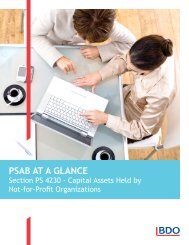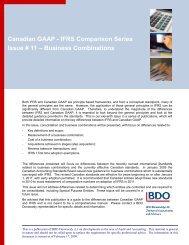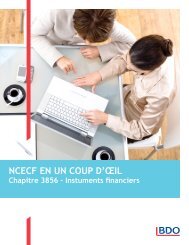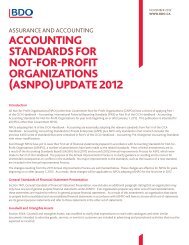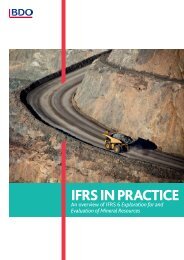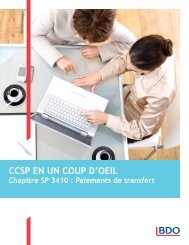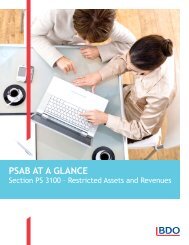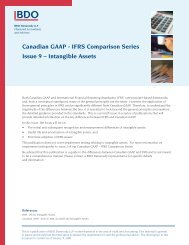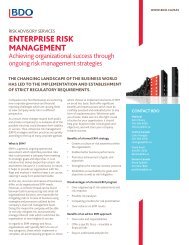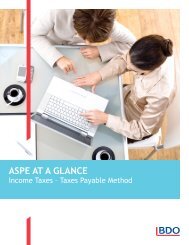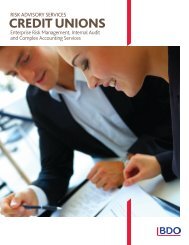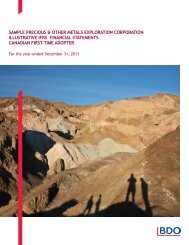Need to Know: IFRS 10 - Consolidated Financial ... - BDO Canada
Need to Know: IFRS 10 - Consolidated Financial ... - BDO Canada
Need to Know: IFRS 10 - Consolidated Financial ... - BDO Canada
- No tags were found...
Create successful ePaper yourself
Turn your PDF publications into a flip-book with our unique Google optimized e-Paper software.
<strong>IFRS</strong> <strong>10</strong> <strong>Consolidated</strong> <strong>Financial</strong> Statements377.6. Specific <strong>to</strong>pics7.6.1. Silos<strong>IFRS</strong> <strong>10</strong> contains guidance which requires an inves<strong>to</strong>r <strong>to</strong> consolidate a portion of an investee (a silo) if the inves<strong>to</strong>ris deemed <strong>to</strong> have control over that portion. This guidance was not included in IAS 27(2008) but was nonethelessapplied in practice. As a result, specified assets and liabilities held by a legal entity may be consolidated as a ‘deemedseparate entity’.The new guidance for silos is likely <strong>to</strong> affect the finance, real estate and insurance industry (e.g. captive insuranceentities or ‘multi-seller conduits’). A common example is where a bank sets up a wholly owned subsidiary, throughwhich a large number of securitisation transactions are processed. For each securitisation, the assets and liabilitiesare entirely ring fenced from the assets and liabilities of all of the other securitisations.In order for a silo <strong>to</strong> exist, all of the following conditions have <strong>to</strong> be met (<strong>IFRS</strong> <strong>10</strong>.B77):––The liabilities of a silo can only be settled with its specified assets––Only parties with the specified liability or liabilities have rights (or obligations) related <strong>to</strong> the assets or <strong>to</strong> theresidual cash flows from those assets––In substance, none of the returns from the silo can be used by the remaining investee(s)––None of the liabilities of the silo can be paid using assets outside the boundary of the silo.An inves<strong>to</strong>r in a silo that meets the criteria set out above is required <strong>to</strong> assess whether it controls the silo basedon the same control criteria that apply <strong>to</strong> other entities. This means that an inves<strong>to</strong>r will have <strong>to</strong> identify if it hasexposure or rights <strong>to</strong> variable returns from its involvement in the silo and the ability <strong>to</strong> use its power over the silo <strong>to</strong>affect its returns (<strong>IFRS</strong> <strong>10</strong>.B78).An inves<strong>to</strong>r only consolidates the silo – not the remainder of the investee. The other party (or parties) that haveinterest(s) in the investee exclude the siloed portion from the entity when assessing control and, if required, will onlyconsolidate the remaining part of the investee (or one or more other silos) (<strong>IFRS</strong> <strong>10</strong>.B79).7.6.2. Structured entitiesStructured entities are defined in <strong>IFRS</strong> 12. The term ‘structured entity’ replaces the term ‘special purpose entity’ inSIC-12. A structured entity is defined in <strong>IFRS</strong> 12 Appendix A as:‘An entity that has been designed so that voting or similar rights are not the dominant fac<strong>to</strong>r in deciding whocontrols the entity, such as when any voting rights relate <strong>to</strong> administrative tasks only and the relevant activitiesare directed by means of contractual arrangements.’A structured entity often has some or all of the following features or attributes:––Restricted activities––A narrow and well-defined objective, such as:––To effect a tax-efficient lease––To carry out research and development activities––To provide a source of capital or funding <strong>to</strong> an entity––To provide investment opportunities for inves<strong>to</strong>rs by passing on risks and rewards associated with the assets ofthe structured entity <strong>to</strong> inves<strong>to</strong>rs.––Insufficient equity <strong>to</strong> permit the structured entity <strong>to</strong> finance its activities without subordinated financial support––Financing in the form of multiple contractually linked instruments <strong>to</strong> inves<strong>to</strong>rs that create concentrations of credi<strong>to</strong>r other risks (tranches) (<strong>IFRS</strong> 12.B22).



